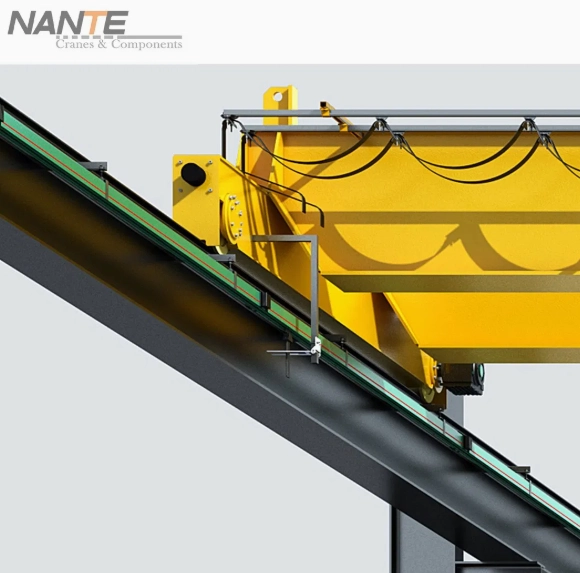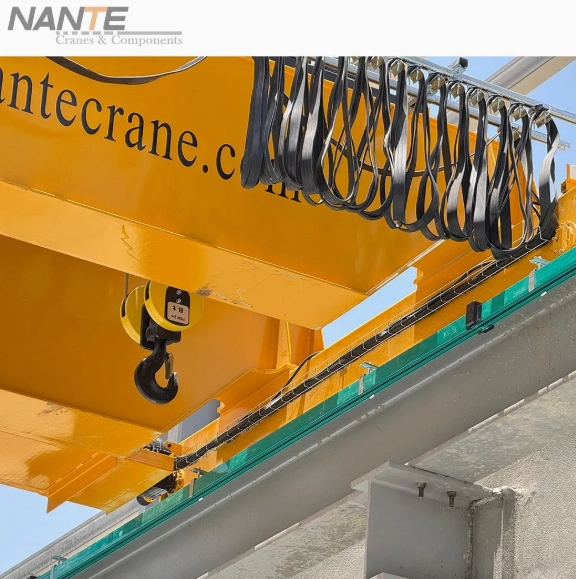How to Choose Overhead Crane Conductor Rails for Reliable Power Transfer
How to Choose Overhead Crane Conductor Rails for Reliable Power Transfer
Date: 2025-08-07 Share:
Introduction
What is Overhead Crane Conductor Rails
Overhead crane conductor rails are vital parts of a crane’s power system. They deliver steady electricity through a sliding connection between fixed rails and moving collectors. These rails help cranes work smoothly and safely. This is especially true in tough industrial places where lifting heavy items or moving often happens. They provide a dependable power source. This reduces stops, boosts work efficiency, and keeps safety high in places like factories, warehouses, and building sites.
Crane Conductor Rails Role in Crane Operations
Conductor rails let cranes glide along tracks without losing power. They are key to electric overhead traveling cranes. These cranes have a moving bridge with a hoist that runs on an overhead track. This setup is common in industries like manufacturing, logistics, ports, and construction. Cranes lift heavy loads with accuracy and dependability.
Crane Conductor Rails Comparison with Other Power Supply Methods
Other power systems for cranes include festoon systems and cable reels. Festoon systems use cables that move on a track or beam. They suit short distances but wear out fast. Cable reels wind and unwind cables. They work for cranes with limited movement but struggle with long distances. Conductor rails shine for their dependability and low upkeep. They support long-distance and heavy-duty crane tasks, making them a top pick for tight spaces or high-demand settings.
Types of Overhead Crane Conductor Rails
Seamless Conductor Rails
Description: Seamless conductor rails have no joints. They ensure steady power flow without breaks.
Advantages: They are very dependable, have little voltage loss, and run smoothly. This reduces wear on collectors.
Application: Perfect for single and double-beam bridge cranes needing constant power for steady work.
Single-Pole Insulated Conductor Rails
Description: These Unipole Conductor rails have an insulating cover to stop electrical dangers.
Advantages: They give strong protection in wet or harsh settings. They lower the chance of electrical problems.
Application: Great for outdoor or marine places, like ports or chemical plants, where moisture or chemicals are issues.
Enclosed Conductor Rails
Description: Fully enclosed rails give extra protection from outside elements.
Advantages: They guard against dust, water, and debris. This boosts durability and safety.
Application: Ideal for tough settings like steel mills or port facilities, where conditions could harm performance.
Copper-Headed Conductor Rails
Description: Made with copper, these rails offer top-notch electrical conductivity.
Advantages: They provide efficient power flow and last longer due to copper’s strength.
Application: Best for high-power needs, like heavy-duty industrial cranes requiring strong power delivery.
Crane Conductor Rails Comparison with Other Power Supply Methods
Conductor Rails vs. Suspended Cable Systems and Cable Reels
- Conductor Rails: Fixed tracks give a steady power supply. They suit long distances and heavy-duty tasks. They work well for cranes on long runways or multi-bridge setups.
- Suspended Cable Systems (Festoon Systems): These use cables and trolleys on a track or beam. They fit short distances and lighter tasks. But cables wear out, and stack-up issues limit their range.
- Cable Reels: These work for cranes with short movement. They wind and unwind cables. They are less effective for long distances due to cable limits and possible blockages.
Crane Conductor Rails Advantages and Disadvantages
- Conductor Rails: They are very dependable and need little upkeep. They support multiple bridges. But setup costs can be high, and collector shoes may need frequent swaps in heavy use.
- Suspended Cable Systems: They are flexible and cheaper for small setups. Yet, cables wear out often and don’t suit multi-bridge runways.
- Cable Reels: They are easy to set up and maintain. But they limit travel distance and don’t work well for complex crane movements or risky settings.
When to Choose Conductor Rails
Conductor rails are the best pick for heavy-duty cranes or long-distance tasks. They also work in tight spaces. They shine in high-demand settings, like large factories or ports. They are great for setups with multiple bridges or plans for future growth.
Factors to Consider When Selecting Conductor Rails
Crane Type and Configuration
- Monorail Cranes: Need simple conductor rail systems due to their single-track design.
- Bridge Cranes: May need rails on two tracks to support bridge and hoist movements.
- Gantry Cranes: Require rails suited for outdoor or heavy-load tasks. They need strong, weather-proof designs.
Power Requirements
- Current Capacity: Pick a conductor rail with the right current capacity (e.g., 200A to 5000A). Base this on the crane’s motor power and work cycles. Overloading can cause power loss or system failure.
- Voltage: Make sure the rail system matches the facility’s electrical system. This prevents inefficiencies or equipment damage.
Environmental Conditions
- Indoor vs. Outdoor: Outdoor settings need enclosed or insulated conductor rails. These handle weather like rain or extreme heat or cold.
- Temperature Range: Materials must handle high or low temperatures without breaking down. For example, copper rails work well in hot settings.
- Corrosive Environments: In chemical plants or marine areas, choose materials like stainless steel or coated rails. These last longer.
Safety Standards and Regulations
- ECMA 35: Gives rules for designing and installing crane power systems. It ensures proper setup and safety.
- OSHA 1910.179: Sets safety rules for cranes, including insulation and grounding to protect workers and equipment.
- Insulation and Grounding: These are key to stop electrical faults, reduce shock risks, and meet safety rules.
Crane Conductor Rails Maintenance and Durability
- Material Selection: Copper has great conductivity but costs more. Aluminum is lighter and cheaper but less conductive.
- Insulation and Protection: Enclosed or insulated rails cut maintenance needs. They protect against environmental damage.
- Longevity: Pick rails built for frequent use and tough conditions. This lowers replacement costs and downtime.
Crane Conductor Rails Installation Considerations
Installation Methods
- Top Installation: Common for bridge and gantry cranes. Rails mount above the runway for easy access.
- Side Installation: Great for tight spaces. Rails mount along the side of the runway or bridge.
- Ground Installation: Rare but used in specific industrial setups where overhead or side mounting doesn’t work.
Alignment and Spacing
Proper alignment of conductor rails stops collector wear and cuts power loss. Calculate support spacing based on rail length, load, and conditions. This ensures stability. Misalignment can cause poor power transfer and more maintenance.
Safety Precautions
- Follow manufacturer rules and safety standards during setup. This avoids electrical dangers.
- Ensure proper grounding and insulation. This protects workers and equipment.
- Use professional installers to meet regulations and prevent accidents.
About Nante Crane
Company Overview
Nante Crane is a top maker of cranes and crane parts in China. It has over 30 years of experience in lifting and material handling tech. Since 2018, it has been a national high-tech enterprise. It focuses on cutting client costs, boosting work efficiency, and saving energy.
Product Range
Nante Crane offers many products. These include single-beam and double-beam bridge cranes, gantry cranes, construction cranes, workstation cranes, marine cranes, and crane parts like mobile power supply systems and conductor rails. Their solutions meet various industrial needs, ensuring dependability and performance.
Why Choose Nante Crane for Crane Conductor Rails
Nante Crane works in over 50 countries. It partners with more than 150 distributors and serves over 5000 end-users. The company pushes tech innovation. It adds crane intelligence, lightweight designs, and IoT features to its products. Nante Crane’s conductor rail solutions are built for durability, efficiency, and safety. They come with great customer service and a focus on quality.
FAQs
Q1: What is the main difference between conductor rail types?
A: Seamless rails give steady power. Insulated rails boost safety in tough settings. Enclosed rails shield against outside elements. Copper-headed rails offer top conductivity for high-power tasks.
Q2: How do I determine the required current capacity for my crane?
A: Calculate based on the crane’s motor power, load capacity, and work cycles. Check the crane’s specs and manufacturer advice.
Q3: Can conductor rails be used in outdoor environments?
A: Yes. Insulated or enclosed conductor rails handle weather, temperature shifts, and harsh conditions.
Q4: What safety standards should I follow when selecting conductor rails?
A: Follow ECMA 35 for power system design. Use OSHA 1910.179 for crane safety. Ensure proper insulation and grounding.
Q5: How often should conductor rails be inspected and maintained?
A: Inspect yearly or per manufacturer guidelines. This depends on usage and environmental conditions.
Contact Nante Crane for Expert Solutions
Picking the right conductor rail is key to boosting crane performance and safety. Nante Crane’s expert team offers tailored conductor rail solutions for your needs.
Contact Information
Visit our website: www.Nanteecrane.com
WhatsApp: +8618668112626
Take Action Now
Ensure steady and efficient power transfer for your crane operations. Contact Nante Crane today. Learn how our advanced conductor rail systems can improve your work efficiency and safety.





